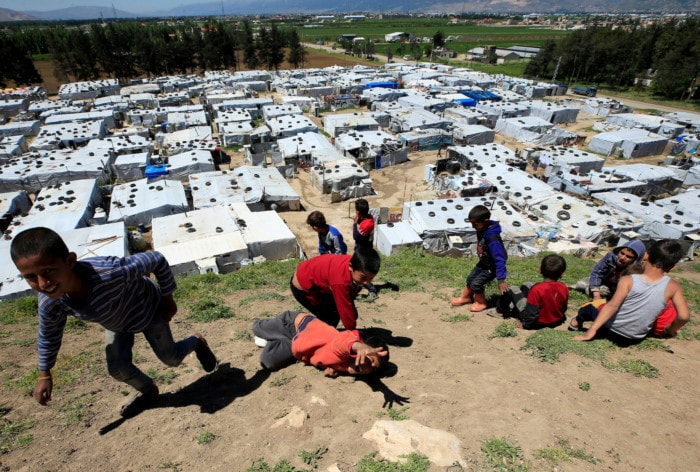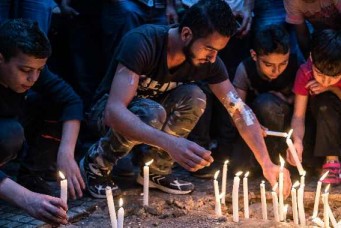What the Beirut Blast means for Lebanon’s Refugees
Inclusive refugee policies and a renewed approach to humanitarian relief will be needed to protect Lebanon’s most vulnerable.

As the world stands to watch a complete humanitarian tragedy unfold in Lebanon because of the recent Beirut explosion, the implications of this disaster will touch many lives for many years to come. One particularly vulnerable group is Lebanon’s refugee population. Currently, Lebanon ranks first worldwide in hosting the largest number of refugees in relation to its national population. By the end of 2019, there were an estimated 910,586 Syrian refugees (registered with UNHCR) – and many more present but unregistered. Among the Syrian refugee population, 69 percent of households live below the poverty line, while 90 percent experience varying degrees of food insecurity. Since 1948, Lebanon has also been hosting a large Palestinian refugee population. In 2019, 476,033 Palestinian refugees were registered with UNRWA in Lebanon, with 180,000 estimated to be residing in the country.
Despite being one of the largest refugee hosting countries in the world, Lebanon has no legal framework that governs asylum. Instead, fluctuating, informal, and inconsistent policies have placed displaced populations in extremely precarious legal situations. Syrian refugees are spread out over 1,700 localities throughout the country, with close to 40 percent of them living in shelters deemed below humanitarian standards or in dangerous conditions; while Palestinian refugees live across 12 formal camps and 42 informal gatherings. No assessment has yet been made of the extent of the damage that refugee housing structures have sustained. Yet, the collapsing infrastructure, the extent of damage sustained city-wide, and the resulting destitution have spelled disastrous consequences for their livelihoods, daily lives, and future options. The Beirut Blast, which comes at the heels of a harrowing financial crash and in the context of the COVID-19 pandemic, presents a “crisis upon crisis scenario” for the small host state and its refugee population.
Here are four important reasons why refugee populations in Lebanon are expected to experience even more precarity in the wake of the Beirut blast.
The shifting landscape of aid
Years of mismanagement and corruption have dealt a blow to the so-called “laissez-faire economy” that Lebanon’s founding fathers had envisaged back in the 1940s. Recent economic collapse and currency devaluation have endangered livelihoods and placed enormous strains on abysmal resources. This time, the international community has vowed not to direct aid to the small polity unless the Lebanese government embarks on profound reforms. In the wake of the blast, however, the architecture of aid in Lebanon is undergoing a critical shift, and priorities are being reconsidered. First, aid that was otherwise being poured into supporting Syrian refugee populations will now be needed for immediate relief and, later, for reconstruction. Second, inexistent international trust in the governing political parties and ministries will mean that funds would have to bypass the state yet again. While short-term initiatives are set to provide immediate relief and humanitarian assistance, Lebanon is yet to reform its moribund institutions so as to benefit from a sustainable and longer-term aid strategy. In the context of shifting aid priorities and hollowed-out local institutions, it is likely that refugee aid will become even more volatile than it was earlier, and that Lebanese ministries would be both overwhelmed and unwilling to channel refugee aid in a structural manner.
A fuzzier and more securitized refugee policy
There is consensus that the explosion was caused by pervasive negligence and bureaucratic malpractice, and Lebanon is set to enter a long-term phase of turmoil and grassroots contestation. Already, there was a revolt under way. What does this mean for refugee policy? The state’s capacity to provide a reliable interlocutor over refugee aid with the international community has been substantially eroded. Furthermore, political turmoil has validated and reinforced already existing premature calls and efforts to repatriate refugees. Indeed, various politicians have capitalized on turmoil and overstretched capacities to call for rash returns and crack down on refugee livelihoods. Against this backdrop, Lebanon’s refugee policy is set to become even fuzzier, more volatile, and more securitized.
Further humanitarian fatigue
In the past few years, civil society and faith-based organizations have filled in for the state in providing refugee aid and protection. Still, as Syria’s conflict has proven to be protracted, host and refugee populations have experienced compassion fatigue. In some of the poor localities, community tensions have been on the rise. With the Beirut blast, it is likely that the political establishment will capitalize on pre-existing tensions to portray refugees as an acute threat to Lebanon’s long-term recovery. Notwithstanding this, refugee and host populations have come together to rebuild the city, debunking stereotypes about lingering hostility.
Grave health repercussions
Efforts to halt the COVID-19 threat were not successful in Lebanon, especially in more vulnerable areas where populations could not apply the “stay home” policy that Lebanon’s government has advocated for since March 2020. In the wake of the Beirut blast, not only has the government lost its capacity to control the spread of the virus, but social distancing has become practically impossible during disaster relief efforts. Indeed, Beirut’s destroyed areas have been exempted from the two-week total lockdown that the Lebanese state had reinstated in August, as Coronavirus cases have substantially increased. Within this climate, it is likely that Lebanon’s refugee population will be particularly vulnerable to the COVID-19 spike, especially with lacking access to healthcare and limited ability to self-isolate in overcrowded and challenging urban contexts.
What’s next? The dilemmas of humanitarian aid
As people are still mourning the loss of their loved ones, heated debate has emerged as to whether the explosion can be swiftly turned into an opportunity for a transformative and systemic overhaul. Indeed, people need time to heal and recover. Thinkers and activists have stressed that this time, unlike the 1990s in which the political establishment had rushed to reconstruct a war-torn Beirut without inclusive deliberations, Lebanese citizens need to carefully reflect on what a post-disaster Beirut will look like. They would also need to carefully ponder options for the emergence of a new home-grown political system that casts off the influence of sectarian warlords. At the same time, both host and refugee communities can no longer rely on versions of humanitarianism and relief aid that celebrate a much-eroded social resilience. Indeed, scholars and activists have vociferously debated narratives of “resiliency humanitarianism” that place the onus on the individual while obscuring the accountability of the state.
In this landscape, the Beirut blast and its implications for both Lebanese citizens and refugees call for a paradigm shift in humanitarian responses. Refugee-led organizations, civil society organizations, activists and practitioners should come together to reflect on what relief and reconstruction aid means for both Lebanese nationals and refugees in times of disasters. History has taught us that humanitarianism may fail to offer more than “a bed for the night”.
Despite its complex ramifications, the Beirut Blast presents the international donor community with an opportunity to rethink its aid strategy both for Lebanon and in the context of displacement from Syria. It calls for implementing a long-term development aid strategy that includes both nationals and refugees as co-stakeholders in rebuilding and disaster mitigation. Also, it calls for rising beyond slogans of short-term resilience, and privileging instead inclusive deliberations in which people’s lives and future trajectories take center stage.



